Volume 24, November 2022

WMO Aircraft-Based Observations Newsletter
Volume 24, November 2022
Contents
- Welcoming Remarks
- Status of Aircraft-Based Observations
- ABOP Water Vapor Measurement
- Aircraft-based Turbulence Observations Status within AMDAR
- TAMDAR and AMDAR-over-AFIRS Update
- The European Meteorological Aircraft Derived Data Center (EMADDC) Update
- Regional program status and developments
- WMO Regional Workshop on ABO-WICAP for South America (Region III) in Cartagena, Republic of Colombia
- Update to WICAP Development
- UAS Demonstration Campaign - Status & Progress
- JET-ABO Second Meeting & Workshop on Aircraft Derived Data
- AMDAR Provides NWS with Upper-Air Data during Helium and Hydrogen Shortage
- Contacts
- Subscription & Links
Welcoming Remarks
On behalf of the JET-ABO co-chairs and the WMO Secretariat, welcome to the October 2022 edition of the WMO Aircraft-Based Observations Newsletter. After more than 2½ years of pandemic-related issues, aircraft activities have started to increase substantially again and we’re happy to report that aircraft-based observations (ABO) are back to near pre-pandemic levels in many areas of the world. Face-to-face meetings also are returning with the first hybrid JET-ABO meeting taking place in June. While the leadership group and a small number of other members attended the meeting in person in Geneva, many others participated virtually. Another highlight of this year was the ADD (aircraft derived data) workshop held the beginning of September in Geneva which also was offered in a hybrid format.
This newsletter features articles about the status of regional programmes, the WVM programme, an update on the UAS Demonstration Campaign that is planned for 2024, WICAP and research involving ABO data. Also included is an update on activities at the European Meteorological Aircraft Derived Data Center (EMADDC), summaries of the RA-I and RA-III ABO workshops as well as an article describing how ABO data were used in the U.S. to supplement radiosonde launch reductions due to a helium shortage. We would like to thank all authors for their contributions to this newsletter and a special thanks to our voluntary editor, Carl Weiss.
Carmen Emmel, Deutscher Wetterdienst (DWD), ABO Coordinator, carmen [dot] emmel dwd [dot] de (carmen[dot]emmel[at]dwd[dot]de)
dwd [dot] de (carmen[dot]emmel[at]dwd[dot]de)
Status of Aircraft-Based Observations
Status of Aircraft-Based Observations
The graphic below shows the smoothed monthly average of daily aircraft-based observations (single point measurements in space and time, mainly of air temperature and wind speed and direction, made by an aircraft) transmitted on the World Meteorological Organization (WMO) Global Telecommunications System (GTS) since 2007 up to October 2022, as contributed by:
- All aircraft and all systems (black);
- From the AMDAR Programme with reports submitted in binary format (BUFR, red);
- From ICAO data sources (AIREP and ADS, purple); and,
- From the FLYHT AFIRS system (blue).
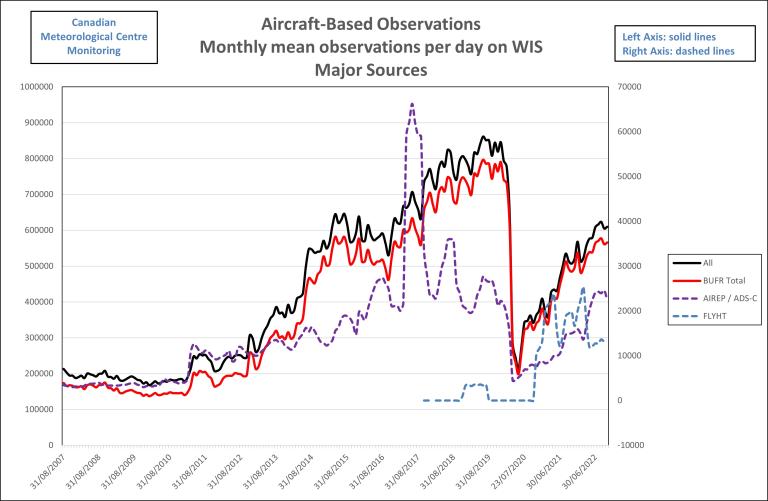
The observations from the WMO AMDAR observing system are the output from 12 operational AMDAR national and regional programmes in cooperation with some 43 national and international participating airlines, as listed on the WMO website.
ABO Data Volumes and Coverage
The graph shows that recently towards the end of 2019 and start of 2020, aircraft-based observations data volumes had increased to a historical maximum of more than 850k observations per day on the GTS, with AMDAR observations making up the majority of these at around 750k observations per day.
From March 2020, as a direct result of the impact of COVID-19 on the aviation industry and airlines, the volume of aircraft-based observations overall fell to around 245k observations per day and to 230k for AMDAR - around 30% of December data volumes for both. The biggest monthly reduction occurred in May 2020, with only an average of 210k observations per day available.
Since then, data levels have gradually increased overall with mean daily total observations at around 610k observations per day in October 2022, which is around 70% of the December 2020 data volume.
The graphic above, courtesy of NOAA, provides an indicative coverage of the full ABO observing system over a 24-hour period, with around 5% of available observations shown on the map.
The graphic below shows ABO data volumes by WMO region since January 2018, where it can be seen that the recovery varies greatly from region to region and on a monthly basis within each region, as countries and regions emerge from the crisis and aviation operations start to increase accordingly.

The greatest impacts have occurred in the southern hemisphere where programme and data loss over Africa and South America has been significant. Fortunately coverage has been to a limited extent offset by several measures including:
- Ongoing provision of EUMETNET/E-AMDAR data over Africa as a result of WMO AMDAR Operating Fund support;
- E-AMDAR extend coverage over Norther Africa; and
- USA support for provision of global FLYHT TAMDAR and AFIRS ABO;
Over the past months throughout 2022, data levels have steadily climbed over the northern hemisphere regions generally, while the southern hemisphere regions and programs continue to struggle.
Availability of ADS-C Data
The graphic below shows an indicative coverage of Automatic Dependent Surveillance - Contract (ADS-C) data, which are derived from air navigation reports shared with WMO under arrangement with ICAO and the relevant Air Navigation Service Providers (ANSP).
ADS-C data generate around 85k observations per day of winds and air temperature on the GTS, at higher altitudes and almost exclusively over oceanic regions. The large part of these data are provided by the USA, derived from many airlines and aircraft within a range of Fight Information Regions, under an arrangement with information service provider, Collins Aerospace. An additional smaller volume of ADS-C data is generated by other national programs in collaboration with their ANSP.
WMO is endeavouring to increase access to ADS-C data over a number of FIRs in which ADS-C data is generated but not on-forwarded to WMO, or else ADS-C data is currently generated without meteorological data included the report.
Outlook for Future of ABO
At the second formal meeting of the Joint Expert Team on Aircraft-Based Observing Systems (JET-ABO), the team was addressed by Mr Kyu-Bin Lim, IATA Economist, who presented an overview of the outlook for the aviation industry, and airlines as the recovery from the downturn due to the pandemic continues. There are positive outlooks for the industry while the travel restrictions are globally easing, people have a willingness to travel, and cargo traffic is increasing. However, there were still risks to the recovery due to various factors, including the debt burden, increased labor costs, increased energy costs, concerns related to climate change and challenges related to geopolitical conflict.
Mr Lim explained that the cargo carrying sector has already reached the 2019-levels (cargo traffic ton kilometers, CTK), while passenger traffic has seen a strong recovery within the major domestic markets. European cargo carriers are impacted by the conflict but there is remarkable performance in Latin America, and overall Air cargo prices have become more competitive compared to marine cargo. International passenger traffic is also on the rise, however, the area of Asia Pacific lags, as uneven travel restrictions remain in place over the region. Forward bookings give a positive outlook for the future, and domestic traffic is already steadying whereas international travel sector is now accelerating.
Based on these and other considerations and other programmatic developments, the JET-ABO is expecting over the short to medium term that:
- Global AMDAR data volumes will continue to gradually increase, although it is unlikely that data volumes will reach 2019 levels without continued efforts to extend AMDAR coverage with new airlines under WICAP, due to programme losses.
- Increased AMDAR data over Africa under WICAP and through collaborative efforts to expand the Kenya AMDAR Programme.
- Recovery and increased AMDAR data availability over South America, subject to cooperation with new airlines partners under WICAP.
- Over the next 2-5 years, ADS-C data volumes and coverage will increase due to WMO efforts to increase availability of these data through national, regional and global endeavours in collaboration with ICAO.
In the longer-term it is expected that:
- Aircraft Derived Data (ADD) data availability will increase, particularly as the EUMETNET EMADDC programme becomes more globally operational and the programme is extended.
- Over the next 2-10 years, ABO data derived from Automatic Dependent Surveillance - Broadcast (ADS-B) data appear and increase with the take-up and deployment of ADS-B version 3.
Thanks to Program Partners
WMO and its Members are grateful to our aviation industry and airline partners for their continued contribution to the WMO Aircraft-based Observing System and the AMDAR Programme. The data that are produced from this collaboration are utilized within many meteorological applications and forecasts, benefiting aviation operations and safety, other application areas and the wider general public.
For more information on aircraft-based observations data statistics visit the WMO Community Platform Aircraft-Based Observations site.
ABOP Water Vapor Measurement
Global Water Vapor Measurement Summary and Update
Aircraft Based Observation (ABO) water vapour data from commercial aircraft currently are measured by two distinct sensor systems: the Second-Generation Water Vapor Sensing System (WVSS-II) and Tropospheric Airborne Meteorological DAta Reporting (TAMDAR). ABO water vapour observations are of high value for weather forecasting in general and especially for aviation weather forecasts.
WVSS-II
Since 2017, 148 commercial aircraft have been equipped with the WVSS-II sensor worldwide with 139 belonging to RA-IV (North America) and nine to RA-VI (Europe). The total number of WVSS-II-enabled aircraft has remained unchanged since then, but as of October 2022, only 131 RA-IV aircraft actively are providing moisture observations. The table below shows the breakdown of WVSS-II reporting aircraft across all WMO Regions.

UPS and Southwest Airlines operate the WVSS-II-equipped aircraft in North America and Lufthansa in Europe.
NOAA/NWS and E-ABO networks provide WVM observations predominantly from their respective geographic regions (RA-IV and RA-VI). However, the participating airlines routinely travel outside the confines of their home territory enhancing the WVM data available in many ABO water vapour data sparse areas.

24 hours of global WVM data on October 16, 2022 (Graphic courtesy of NOAA/ESRL/GSD)
RA-I Water Vapor Measurement
There are currently no operational implementations of WVSS-II within RA-I.
RA-II Water Vapor Measurement
There are currently no operational implementations of WVSS-II within RA-II.
RA-III Water Vapor Measurement
There are currently no operational implementations of WVSS-II within RA-III.
RA-IV Water Vapor Measurement
During the third quarter of 2022, a total of 131 individual aircraft from Southwest Airlines and the United Parcel Service were equipped with active WVSS-II sensors that provided water vapor profile observations throughout the RA-IV region on a daily basis. During July and August, the participating carriers combined to contribute no fewer than 1000 water vapor profiles daily. Fewer observations were produced in September corresponding to a primarily seasonal reduction of flight activity from Southwest Airlines. Beyond the contiguous United States, Southwest Airlines continues to feature aircraft routes to the Caribbean region and to Hawaii while UPS aircraft operate some transoceanic routes across the Pacific and the Atlantic.
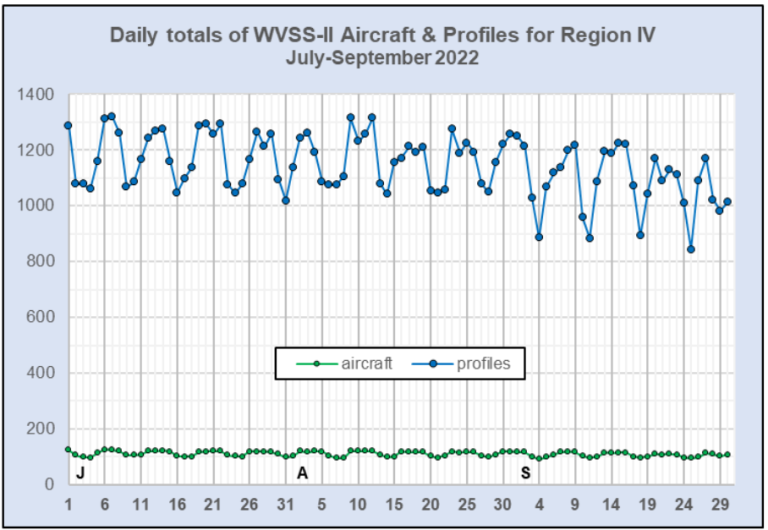
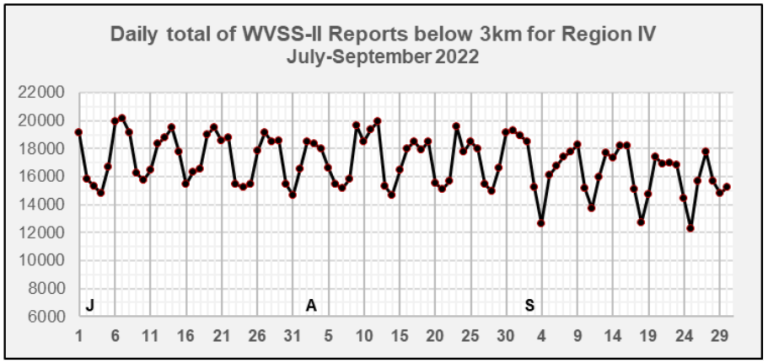
The accompanying graphs depict the daily totals of aircraft, profiles of water vapor data proximal to airport locations and total singular reports of water vapor below the 3km vertical level through the period of July 1 to September 30, 2022.
RA-V Water Vapor Measurement
There are currently no operational implementations of WVSS-II within RA-V.
RA-VI Water Vapor Measurement
After two years of very limited AMDAR water vapour observations over Europe with no more than four WVSS-II equipped aircrafts flying at any time, we saw a quick return to eight active WVSS-II-equipped aircraft in April 2022. Since then, all eight aircraft have been providing water vapour observations almost continuously reaching approximately 75% to 80% of the pre-COVID data levels. The ninth aircraft, which has been grounded since the beginning of the pandemic, is expected to return to operation in December.
The graph below shows the variability in WVSS-II observations since January 2019.
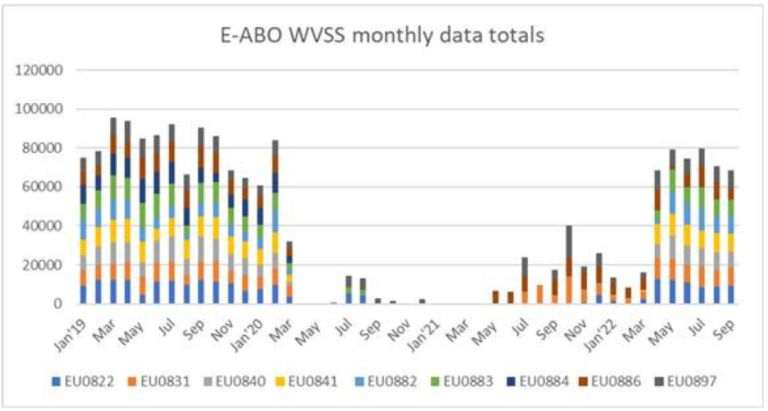
The following figure shows the RA-VI coverage of WVSS-II data over a one-week period (October 7 to 13, 2022).
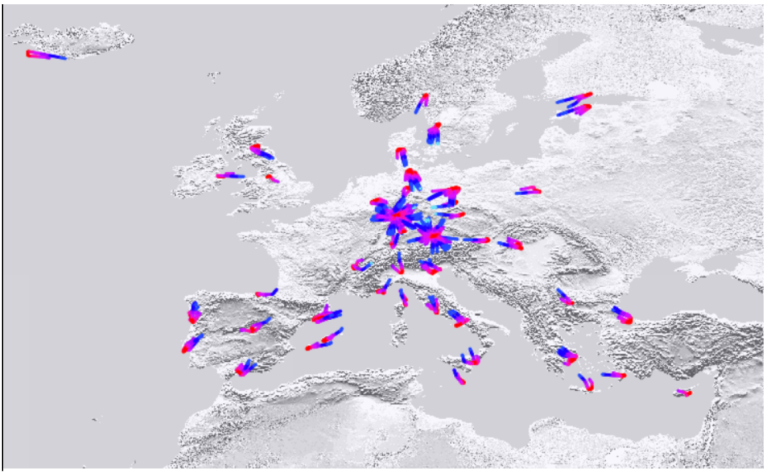
The Met Office has approached a number of UK-based airlines to participate in its planned project to install up to 30 WVSS units. Some progress finally can be reported in that one of these airlines recently has agreed, subject to contract, to install sensors on 13 aircraft in its Embraer fleet. While this is short of the original anticipated number, the fleet will be able to cover the majority of the UK on a daily basis. In order to fill in the missing data around London, the Met Office still is trying to convince a second airline to participate. The main issue faced is finding the time for a reduced and stretched airline staff to discuss the project.
TAMDAR
Relative humidity observations from TAMDAR soundings increased over the summer months especially over Asia and North America and were also available over Central America, Europe and the South West Pacific region. Retirements of TAMDAR-equipped aircraft will bring about a reduction of soundings in the coming months but FLYHT is trying to compensate for this data loss. For more details on TAMDAR observations and data distribution, please refer to the newsletter article on “TAMDAR and AMDAR-over-AFIRS Update.”
Carmen Emmel, Deutscher Wetterdienst (DWD), ABO Coordinator, Carmen [dot] Emmel dwd [dot] de (Carmen[dot]Emmel[at]dwd[dot]de)
dwd [dot] de (Carmen[dot]Emmel[at]dwd[dot]de)
Aircraft-based Turbulence Observations Status within AMDAR
There are two atmospheric turbulence intensity metrics currently used by the AMDAR community. The first metric is eddy/energy dissipation rate (EDR). MacCready (1964) first suggested the use of EDR as a measure of turbulence intensity. It is particularly useful operationally since EDR along the vertical direction is proportional to the RMS (root-mean-square) vertical acceleration experienced by an aircraft for any given flight condition (MacCready 1964; Cornman et al. 1995). Further, EDR has been adopted as the standard metric for atmospheric turbulence reporting by the International Civil Aviation Organization (ICAO) (2001).
Figure 1 shows the locations of available EDR reports for October 2022. Currently, more than 1,700 aircraft are reporting EDR worldwide with an average of just under 85,000 observations per day.
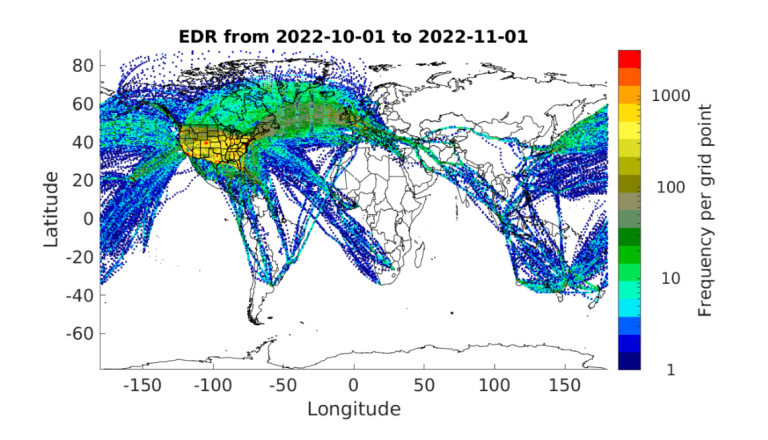
Figure 1: Counts of all available EDR reports for October 2022 using an approximately 50x50 km grid. The color scale is logarithmic.
The second metric, derived equivalent vertical gust (DEVG), is defined as the instantaneous vertical gust velocity which, when superimposed on a steady horizontal wind, would produce the measured acceleration of the aircraft. The effect of a gust on an aircraft depends on its mass and other characteristics, but these factors are accounted for so that a gust velocity can be calculated which is independent of the airframe.3 Currently, there are at least 150 aircraft (probably actually more than 650) reporting about 40,000 measurements per day. These numbers are based on an analysis of AMDAR data from The U.S. National Centers for Environmental Prediction’s (NCEP) Meteorological Assimilation Data Ingest System (MADIS). A large fraction (85%) of the DEVG data appears under a single tail number, which is clearly unrealistic, and thus the estimated number of aircraft reporting DEVG is substantially underestimated. Figure 2 shows the locations of all DEVG reports for October 2022. There is software-based logic implemented on many aircraft that limit reporting of DEVG in some regions at certain altitudes (e.g., Europe). DEVG reporting has increased over North America but continues to be precipitously low in Asia and the Southern Hemisphere with the notable exception being over Australia.
These maps illustrate the need for expansion of aircraft-based turbulence observations in many areas of the globe. WMO continues to work with its Members and their respective national airlines to increase aircraft-based turbulence observation coverage.

These maps illustrate the need for expansion of aircraft-based turbulence observations in many areas of the globe. WMO continues to work with its Members and their respective national airlines to increase aircraft-based turbulence observation coverage.
WMO and its Members express gratitude to our aviation industry and airline partners for their continued contribution to the WMO Aircraft-based Observing System and the AMDAR program. The data produced from this collaboration are utilized within many meteorological applications and forecasts benefiting aviation operations and safety, other application areas and the wider general public.
For more information on aircraft-based observations data statistics visit the WMO website.
Gregory Meymaris, National Center for Atmosphere Research
TAMDAR and AMDAR-over-AFIRS Update
TAMDAR
TAMDAR soundings showed an upsurge during this past summer. Possible contributing factors to this rise include,
- increased air traffic during the summer travel season,
- reduced COVID numbers leading to
- relaxing of global mask mandates.
From June 1st through September 30th, 89 active TAMDAR-equipped aircraft produced a monthly average of nearly 23,000 soundings. Most of this increase occurred over the North American and Asia regions. Unfortunately, we have begun to experience a drop in TAMDAR sounding counts and will continue to see a decrease over the next several months due to the retirement of some aircraft in the North American region. FLYHT is working to determine the final location of these retired aircraft and, if possible, reactivate the TAMDAR sensors.
The TAMDAR table for June through September shows that the majority of soundings came from the North America, Central America and the Caribbean WMO region as well as the Asia and South-West Pacific regions.
TAMDAR Aircraft and Sounding Count
|
WMO Region |
Aircraft Count |
Total Soundings |
|---|---|---|
|
Grand Total |
89 |
91,932 |
|
Asia & South-West Pacific |
36 |
44,117 |
|
Europe |
1 |
44 |
|
Europe & North America, Central America & the Caribbean |
7 |
2,675 |
|
North America, Central America and the Caribbean |
45 |
45,096 |
The image below shows a map of TAMDAR observations for September 2022 in the regions where they were produced. The color of the observation denotes the GPS altitude in feet.
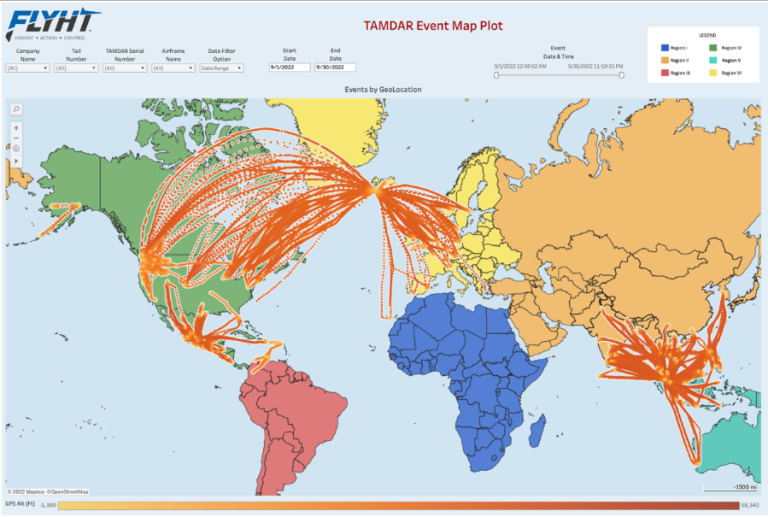
FLYHT AMDAR-over-AFIRS
FLYHT is providing AMDAR-over-AFIRS data coverage over all WMO regional associations. The following image depicts the AMDAR-over-AFIRS data coverage for the period of September 1st through September 30th. The amount of data remained consistent throughout the summer with an average of approximately 15,000 monthly soundings from June 1st through September 30th from a total of 89 reporting aircraft. FLYHT continues to work with additional airlines to potentially increase data availability over various regions of the world.

AMDAR-over-AFIRS Aircraft and Sounding Count
|
WMO Region |
Aircraft Count |
Total Soundings |
|---|---|---|
|
Grand Total |
89 |
59,277 |
|
Africa |
17 |
18,088 |
|
Asia |
5 |
2,298 |
|
Europe |
6 |
4,490 |
|
North America, Central America and the Caribbean |
42 |
20,540 |
|
North America, Central America and the Caribbean & Europe |
13 |
5,991 |
|
South-West Pacific |
6 |
7,870 |
Meredith Bell, FLYHT Aerospace Solutions Ltd. mbell flyht [dot] com (mbell[at]flyht[dot]com)
flyht [dot] com (mbell[at]flyht[dot]com)
Curtis Marshall, NOAA National Weather Service, Chair, JET-ABO, curtis [dot] marshall noaa [dot] gov (curtis[dot]marshall[at]noaa[dot]gov)
noaa [dot] gov (curtis[dot]marshall[at]noaa[dot]gov)
The European Meteorological Aircraft Derived Data Center (EMADDC) Update
About EMADDC
The European Meteorological Aircraft Derived Data Center (EMADDC) is a component of the EUMETNET Aircraft Based Observation Programme and is operated by the Royal Netherlands Meteorological Institute (KNMI).
EMADDC’s objective is to obtain as many high-quality meteorological upper-air observations across the whole of Europe as economically as possible. This is accomplished by operating a service tasked with collecting, processing and disseminating aircraft derived data such as Mode-S Enhanced Surveillance (EHS) and Meteorological Routine Air Report (MRAR) thereby providing quality-controlled upper-air observations of temperature and wind direction and speed.
Modern aircraft carry sensors to measure the Mach number (using a pitot static probe) and air temperature (T). An enhanced surveillance air traffic control radar interrogates, in a selective mode (Mode-S), all aircraft within range. These aircraft reply with a message containing, for example, magnetic heading, airspeed and Mach number. The messages are collected by air traffic control or by a network of local receivers. EMADDC has developed algorithms to derive calibrated and quality controlled meteorological observations from these messages.
Status
The current version of EMADDC is release 2.2 (R2.2). In 2022 two releases have been terminated, R1.6 (MUAC) and R2.1 (COVID-19). The current geographical coverage of EMADDC is centered around Western Europe, see Figure 1. Approximately 50 million Mode-S EHS messages are being processed daily resulting in 30 million wind and 20 million temperature quality-controlled derived observations. Details of the EMADDC system and processing have been provided at the WMO INFCOM/JET-ABO Workshop in September 2022. Presentations and recordings on EMADDC are available on the WMO website.
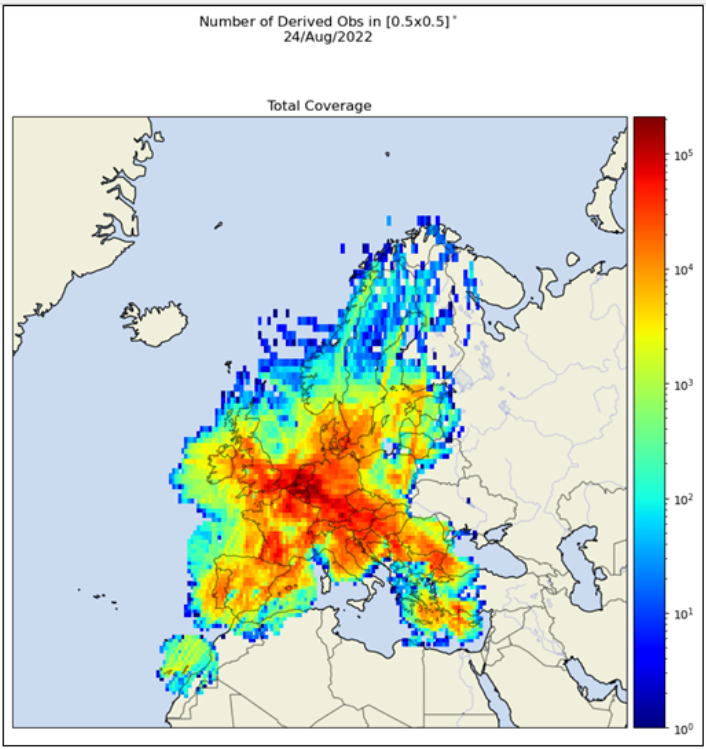
Figure 1: Geographical coverage and density plot of EMADDC operational system, R2.2
Data Quality of R2.2
The output of release 2.2 contains more observations with improved data quality. It also provides data from all suppliers in a single file. Also, MRAR data are now available as a separate product, but they are not yet quality controlled.
The quality of the EMADDC processing is determined by comparing the EMADDC observations to two models over a long period using historical data. The comparison is done with HIRLAM before June 2020 and later with ECMWF.
Notable is the increase in the number of observations up to 2020 and then the sharp decrease due to COVID-19 which coincided with a sharp reduction of air traffic, see figure 2.
The temperature bias shows an increase after the change from HIRLAM to ECMWF.

Figure 2: EMADDC R2.2 statistics compared to NWP model over the period 2016-2022
The temperature and wind speed observations are compared to NWP equivalents (with a forecast lead time of minimally nine hours) and radio sounding observations over a six-month period starting in January 2022, see figure 3.
The temperature bias is in the order of 0.1°K for all three intercomparisons. The temperature standard deviation decreases with increasing height for Mode-S EHS comparisons. When radiosonde observations are evaluated with the model, the standard deviation shows a small increase towards the surface. The anomalies at FL 150, 200 and above FL 300 clearly are related to the radiosonde observations because the Mode-S EHS versus model forecasts do not show these signatures. Note also that the number of observations is small near the surface.
The mean wind speed difference statistics between radiosonde and Mode-S EHS are very small over large portions of the atmosphere. Both Mode-S EHS and radio sounding observations show a mean difference of approximately 0.5 m/s when compared to the model solution.
A comparison of standard deviation shows that the result between Mode-S EHS and the model is largest over almost the entire profile. Between FL 50 and 175, which is approximately 1500m and 5km, the Mode-S EHS and radiosonde observations compare best with respect to standard deviation.
This could be the effect of the model smoothing out small-scale structures which are resolved by Mode-S EHS and radio soundings. A comparison of both observing systems also reveals a smaller standard deviation.
Overall, the quality of Mode-S EHS from the EMADDC processing chain is good.
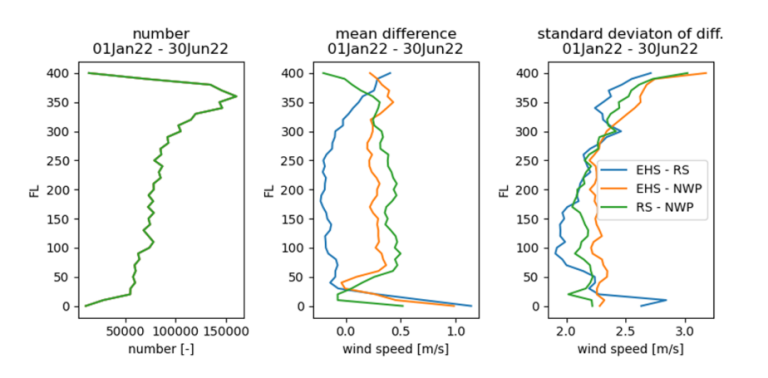
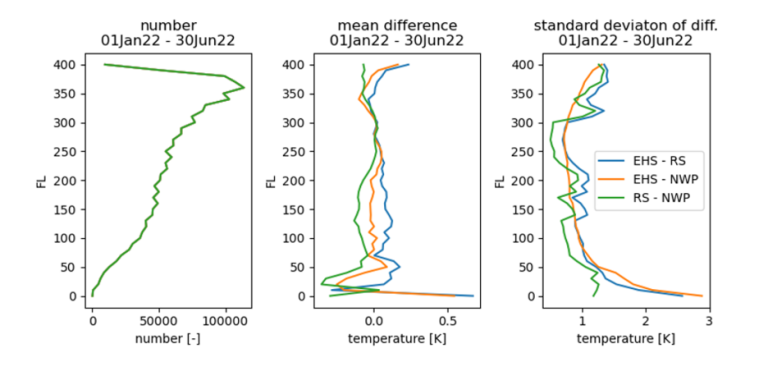
Figure 3: EMADDC R2.2 statistics compared to NWP model and radio sounding over the period January - June 2022
Next Steps
Data currently are being made available to EUMETNET members and ECMWF via Secure File Transfer Protocol (SFTP). A data portal will be developed in 2023 to enable users to retrieve the EMADDC data.
Upgrades in 2023 aim to increase the geographical data coverage and improve near-real-time processing and methods of data collection via, e.g., the new pan-European network service (NewPENS) for aviation. This includes a migration of the EMADDC processing system to the cloud. Initiated by the UK Met Office, a trial to process global Mode-S EHS data provided by Flight Radar 24 will take place in early 2023.
To receive regular updates of the EMADDC developments, visit the EMADDC website or register to the news section on https://emaddc.com.
Jan Sondij MBA, Senior Advisor Aviation Meteorology and Programme Manager of EMADDC, KNMI The Netherlands
Regional program status and developments
Status of RA-I Aircraft Meteorological Data Relay (AMDAR) Programme
The Regional Association-I (RA-I) Aircraft-Based Observation (ABO-RA-I) programme has created a Task Team on Aircraft-Based Observation (TT-ABO-RA-I). Terms of reference for the task team were crafted and submitted to the regional association for endorsement. One of the key activities of the task team was to review the AMDAR Regional Implementation Plan (A-RIP-RAI) which was last approved in 2015. An updated A-RIP-RA-I has been completed.
The two operational AMDAR programmes within Regional Association I are,
- Kenya Meteorological Department AMDAR programme (KMD) and
- South African AMDAR programme (SA-AMDAR)
The SA-AMDAR programme was severely impacted during the COVID-19 pandemic when air travel came to a total halt. South African Airways (SAA) experienced serious challenges during this period and to date has not fully recovered. Only seven SAA aircraft (out of 42) which were operational prior to COVID-19 are back in operation. There are, however, plans to steadily increase the fleet as the pandemic subsides.
The KMD AMDAR programme, which is still in the developmental stage under the UK Department for International Development (DFID) Weather and Climate Information Services for Africa (WISER) programme, have two aircraft which are fully enabled to provide AMDAR profiles. Plans are well under way to activate the remaining aircraft.
The development of the Moroccan AMDAR programme, in collaboration with the EUMETNET E-ABO programme, also has been adversely impacted by the COVID-19 pandemic. Plans to continue this activity are being initiated.
The TT-ABO-RA-I, with the support of WMO secretariat, continues to reach out to regional airlines with the objective to seek participation from other air carriers. With the WMO IATA Collaborative AMDAR Development Programme Agreement (WICAP) in place, TT-ABO-RA-I has planned a series of virtual meetings to capitalize on this opportunity to partner with airlines. A survey was conducted to identify candidate airlines and to determine the onboard capabilities of their aircraft to be AMDAR enabled.
The latest WICAP event, September 28, 2022, established a closer collaboration between all regional stakeholders. A meeting is planned for December 6 through 8, 2022 in Addis Ababa, Ethiopia to further plans to enhance AMDAR growth regionally.
Francis Mosetlho, RA-I ABO Coordinator
WMO Region III ABO Status
Since December 2021, LATAM Airlines has stopped AMDAR data provision for all its branches across South America. Hence, there are no operational airlines providing data in RA III currently. Although there were meetings between LATAM, NOAA and DPSs, data delivery wasn’t reestablished because of financial issues related to the pandemic.
TT-ABO III activities
During Q1 and Q2, the Task Team on Aircraft-based Observation for Region III (TT-ABO III) held WMO-IATA Collaboration on AMDAR Program (WICAP) teleconference meetings with national representatives from Argentina, Bolivia, Chile, Peru and Uruguay. Regional matters such as an ABO-Regional Implementation Program (A-RIP) update, requirements and 2022-23 WICAP implementation for RA-III also were discussed. During July 2022, TT-ABO III held the first face-to-face meeting at the WMO ABO-WICAP Workshop in Cartagena de Indias, Colombia. Participants from Argentina, Brazil, Chile, Colombia, Guyana, Peru and Uruguay discussed important matters related to WICAP implementation in RA III such us financial issues, airline approaches and regional collaboration (for additional details, please see the RA III workshop article in this newsletter).
Argentina (AR)-AMDAR
Communications with JET-SMART have been established in Q2 2022. Although this airline initially showed interest in joining the ABO program, no significant progress has been made. Conversations with other Argentinian national airlines through an IATA national representative are expected in Q4 2022.
Brazil (BR)-ABO
The Brazilian ABO program also has not escaped the effects of the pandemic and the resulting cessation of LATAM AMDAR provision (fig. 1). While ADS-C data delivery remained quasisteady, AMDAR data from former TAM airlines have fallen to zero.

US-LATAM Program
Due to pandemic-forced border and airspace closings since March 2020, the LATAM program has been seriously affected due to the bankruptcy of the airline. This, plus increased downlink regional costs, forced LATAM to stop providing data permanently of December 2021. The US will continue to support the LATAM-data stream processing when the airline is ready to start providing data again next year as the economy recovers.
Nicolás Rivaben, Vice Chair, JET-ABO/ Chair, TT-ABO III, nrivaben smn [dot] gob [dot] ar (nrivaben[at]smn[dot]gob[dot]ar)
smn [dot] gob [dot] ar (nrivaben[at]smn[dot]gob[dot]ar)
WMO Region IV ABO Update
The RA-IV program consists of the USA and USA-based AMDAR-enabled airlines and FLYHT TAMDAR and AFIRS-AMDAR, Mexico and AeroMexico, and Canada and Canadian data sources from FLYHT. In partnership with RA-III, the USA Program also provides AMDAR reports over South America from LATAM. The USA AMDAR program additionally provides ADS-C en route wind and temperature reports roughly every 14 minutes on transonceanic and long-haul routes around the globe.
As of October 2022, RA-IV daily data volume for AMDAR reports have returned to about 80% of their pre-pandemic normal. Owing to pandemic-related financial issues, the provision of reports from LATAM continues to be severely curtailed. We continue to work to find at least a partial resumption of the data at some point in the future. We also are also pursuing some leads with other airlines in South America.
In collaboration with the Joint Expert Team on Aircraft-Based Observing Systems (JET-ABO) and partner NMHSs, the USA is actively exploring the inclusion of new and novel data sources in its ABO program. These include a test feed of Mode-S data with global coverage originating with FlightAware. The USA currently is evaluating this data for quality and closely coordinating with other NMHS partners on its utility in a globally coordinated approach to Mode-S provision.
Canada is working actively to expand its AMDAR program through partnerships with data providers and airlines, but the announcement of an increase in reporting aircraft of 150% is delayed due to technical difficulties at implementing the AMDAR software on the targeted fleet. Updates will be forthcoming through future AMDAR newsletters.
The Canadian AMDAR Program is pleased to announce that the MET data from ADS-C bulletins coming from the Edmonton–FIR are now available in each single ADS-C bulletin since May 19, 2022. This addresses the frequency issues noted by users after the March 24th, 2022 implementation of MET data availability in only one out of five bulletins.
Curtis Marshall, USA AMDAR Program Lead, RA-IV ABO Focal Point curtis [dot] marshall noaa [dot] gov (curtis[dot]marshall[at]noaa[dot]gov)
noaa [dot] gov (curtis[dot]marshall[at]noaa[dot]gov)
Frédéric Lenormand, Canadian AMDAR Program Lead Frederic [dot] Lenormand ec [dot] gc [dot] ca (Frederic[dot]Lenormand[at]ec[dot]gc[dot]ca)
ec [dot] gc [dot] ca (Frederic[dot]Lenormand[at]ec[dot]gc[dot]ca)
WMO Region VI ABO Update
Highlights
- Summer airline schedules brought us virtually back to ‘normal’ in terms of numbers of observations from all ABO types, but both area and airport coverage is still falling short of minimum requirements
Total monthly ABO by type
|
2022 |
EU AMDAR |
AIREPS |
AFIRS |
TAMDAR |
OTHER AMDAR |
|---|---|---|---|---|---|
|
July |
1,656,380 |
669,042 |
97,435 |
31,966 |
1,511,383 |
|
May |
1,445,290 |
616,789 |
77,444 |
32,709 |
1,360,512 |
|
March |
1,367,083 |
445,679 |
75,983 |
21,525 |
1,056,819 |
|
January |
1,096,196 |
391,087 |
105,680 |
20,434 |
977,139 |
-
While not all performance criteria have been met, all have improved over the summer period.
-
We still only have eight out of nine WVSS-equipped aircraft in operation, but the ninth is expected to return to service by the end of 2022.
-
The European Meteorological Aircraft Derived Data Center (EMADDC) has terminated release versions 1.6 (MUAC data only) and 2.1(multi-source, developed during COVID) and now operationally is running release 2.2. Huge numbers of Mode-S EHS data now are being generated. During the last week of August 2022 alone, roughly 300 million wind and 180 million temperature, quality controlled observations were made available to users.
-
Despite limited travel restrictions within Europe, the airline industry as a whole has experienced a range of well-publicised issues that are preventing us from moving forward with ‘non-essential’ developments. This impacts our ability to further advance ABO.
-
The Russian/Ukraine conflict and subsequent flight bans (along with the data gap) continue to adversely impact the routes of some airlines, most notably Finnair and SAS and their Asian routes. Despite this, NWP users have not noticed any impact on global models or upper-air wind forecasts – which should be reassuring to stakeholders!
-
The Polish airline LOT has installed and has started testing AMDAR software on their Embraer fleet. This is the first ‘regional aircraft type’ trialed in Europe for reporting AMDAR. Initial results show an issue with negative temperatures which we hope can be corrected soon.
-
Turkish Airlines (THY) and the Met Office have signed a data license agreement for AMDAR reporting from their B737 fleet. Initial tests of THY data are very positive and with just four aircraft currently reporting. The hope for improved coverage over Turkey and surrounding regions is very promising.
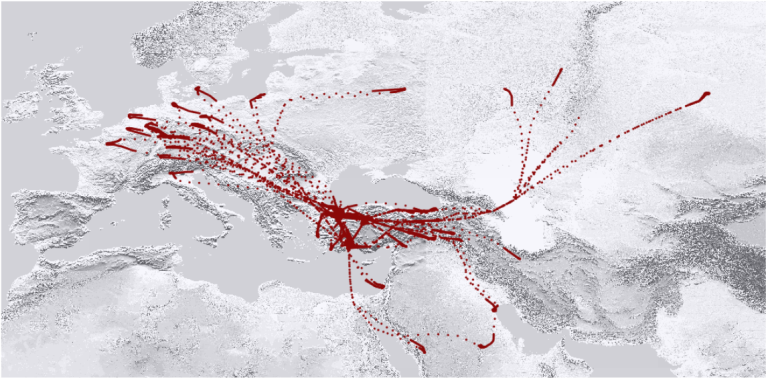
Turkish Airline coverage from four aircraft, Oct 27th to Nov 3rd, 2022
-
The EUMETNET E-ABO programme has started looking forward to its next phase, 2024-2028, with the initial draft of a requirements document which will be reviewed widely and approved over the next six months
-
A discussion with users suggests that AFIRS data, which have been available since May 2020, have had beneficial impact on NWP, especially in regions where there is little other ABO/upper-air data available. This is not surprising but nonetheless is good to have confirmation.
-
Work on WICAP and its implementation has continued at a slow pace with a number of issues affecting the programme. It has become clear that, unlike EUMETNET, each WMO regional association faces problems with establishing a collaboration among NMHSs to fund and manage a regional AMDAR programme, preferring instead to remain with individual national programmes where they already exist. Even in RA-VI, we have issues caused by the political implications of the Russia/Ukraine conflict which means we are currently unable to move WICAP forward for the whole of RA-VI.
-
Irrespective of region, we still need engagement by the airlines to advance WICAP, but until they are back on a sustainable footing, we are unlikely to have the first airline agree to participate in WICAP until well into 2023. Acquiring the first airline is a key WICAP objective for 2022/23. Another important objective is starting a programme in Africa, where the biggest positive impact from new AMDAR data is expected.
Issues
-
The airline industry is still in crisis mode and not expected to recover to 2019 levels until the end of 2023, probably 2024, according to the latest review by EUROCONTROL. This continues to negatively impact E-ABO development with only those items considered critical to airline operations being given any form of approval. Unfortunately, this means that many of the originally planned regional E-ABO advances are still on-hold.
-
The strong US dollar vs the Euro is causing an affordability issue for AMDAR data. If the dollar stays strong for much longer, we will have to cut-back on the amount of AMDAR data generated within the region!
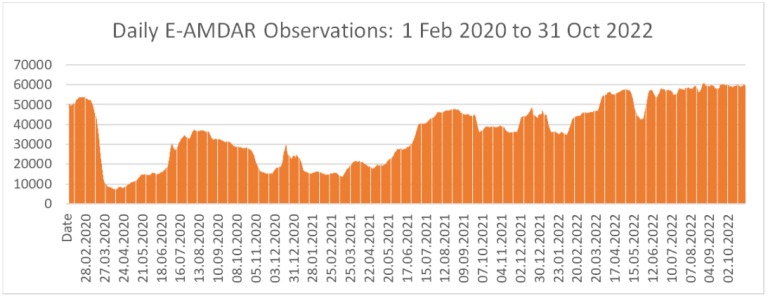
Steve Stringer, E-ABO Programme Manager and RA-VI TT-ABO Lead
WMO Regional Workshop on ABO-WICAP for South America (Region III) in Cartagena, Republic of Colombia
The World Meteorological Organization (WMO) workshop for Regional Association III (RA-III) on the WMO and International Air Transport Association (IATA) Collaborative AMDAR Programme (WICAP) was held at Hotel Estellar in Cartagena de Indias, Colombia from July 18 to 20, 2022. The workshop was hosted by Instituto de Hidrología, Meteorología y Estudios Ambientales (IDEAM - Colombia).
Sixteen participants attended the workshop both in person and virtually including representatives from both the air transport industry and national meteorological and hydrological services (NMHSs) as well as invited experts. The objectives of the workshop were to report on the current ABO activities and to discuss how to advance the development and operation of the WICAP program in RA-III.
The workshop was part of the RA-III Technical Conference where seven parallel workshops or meetings took place over the same week. The meeting was opened by Dr. Yolanda Gonzalez Hernandez, Permanent Representative of Colombia and President of RA-III, Dr. Wenjian Zhang, Assistant Secretary-General, Dr. Julian Baez Benitez, Director of the Regional Office for the Americas, Dr. Gaston Torres, Chair of RA-III Working Group on Infrastructure and Technological Development (ITD-WG) and Dr. Daniel Vila, RA-III Technical Coordinator for Infrastructure. They welcomed all participants to the workshop and to Colombia and emphasized the importance of upper-air observations for aeronautical weather services and observations provided through the public-private engagement.
Ms. Minna Huuskonen, WMO Scientific Officer and representative from the WMO Secretariat, introduced WICAP and the work of the Coordination Group on WICAP (CG-WICAP) under the Joint Expert Team on Aircraft-Based Observing Systems (JET-ABO). Also, she presented the results from the WICAP Target Airline Analysis which assesses the technical readiness of a candidate airline to join AMDAR.
The Task Team on Aircraft-Based Observations for Region III (RA III TT-ABO) Chair, Nicolás Rivaben, explained that over the past two years, the Task Team has developed its Terms of Reference (ToR), workplan for 2022-2023, ABOP Regional Implementation Plan (A-RIP), a list of target airlines and the regional WICAP Risk Register. Mr. Rivaben also presented the status of the RA-III national ABO programmes and emphasized the challenges these national programmes face, which include:
- internal communication issues between Air Navigation Service Provider (ANSP) / Civil Aviation Authority (CAA) and NHMSs,
- financing of the national/regional ABO programmes – funding issues,
- communication with airlines, and
- lack of data service providers in South America
These issues were confirmed by reports from the Argentina, Brazil, Chile, Colombia, Guyana, Peru and Uruguay representatives.
In parallel with the ABO-WICAP workshop, the RA-III Management Group also was meeting where Mr. Rivaben was invited to give a presentation on benefits, impacts and cost implications of the ABO and WICAP programmes in RA-III. He explained four potential ways of funding current ABO regional development and the potential for future ABO expansion in RA-III.
Dr. Curtis Marshall, NOAA ABO Programme Manager and Chair of JET-ABO, described the US ABO programme to the TT-ABO members. Mr. Frédéric Lenormand, member of RA-IV Expert Team on Surface-based Observations and WICAP (ET-SBW), attended the workshop virtually and discussed current regional activities.
One key point covered during the workshop was the stoppage of data provision from LATAM and how new options for improving data coverage over South America could be found. The workshop agreed on a targeting approach to obtain AMDAR data from COPA and Avianca and to investigate opportunities to acquire other existing ABO sources. In this regard, there is a relatively large set of Mode-S data available over the Caribbean and coastline of South America that potentially could be obtained.
Mr. Edgar Sanchez Canosa, Manager of Operations-Safety-Security from the IATA Americas Field Offices, Colombia and Capt. Brent King, Head Flight Operations, Operations-Safety-Security and Technical Operations attended the session virtually. Mr. Canosa introduced the IATA organization structure and IATA’s role in WICAP. With the support of IATA, collaboration with two regional target airlines was initiated and further advanced in one-on-one meetings. Communications with Avianca (Colombia) and Azul Linhas Aereas (Brazil) were discussed after the workshop concluded.
Towards the closure of the workshop, takeaways, key issues and actions were identified. Several items were discussed including the status of an A-RIP, the collaboration in RA-III under WICAP, the future of the LATAM AMDAR programme and the potential for recruiting new airlines through IATA. It was agreed that a follow-on meeting will be held on November 7, 2022.
The final workshop report, including the notes from the RA III NMHS representatives meeting, can be found at WMO SharePoint.
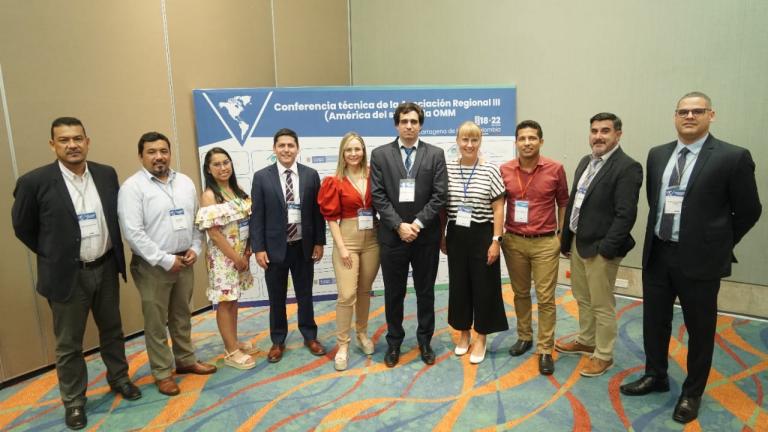
RA III Task Team on ABO Members who attended the WMO ABO-WICAP Workshop during July 18-20, 2022
Nicolás Rivaben, Chair of TT-ABO III and Vice-chair of JET-ABO
Update on WICAP Development
The previous edition of the ABO Newsletter updated readers about the ongoing work of the Coordination Group for the WMO-IATA Collaborative AMDAR Programme (CG-WICAP) and the results of the WICAP Target Airline Analysis which determined the readiness of the WICAP candidate airlines to join AMDAR. Also, the developmental and operational costs for participation in the program were estimated.
The development of the WICAP legal framework recently has been completed by CG-WICAP endorsing the template for the WICAP Airline Participation Agreement. The template agreement gives a baseline for the negotiating parties, namely an airline and a WICAP Operator (NMHS), to agree on the parties’ roles and obligations to meet the requirements for provision of AMDAR data and the protection of their property rights and other interests. This template easily can be adapted for parties’ use based on their needs and requirements.
CG-WICAP also has provided the revised version of the WICAP Implementation Plan to the WMO Commission for Observation, Infrastructure and Information Systems (Infrastructure Commission, INFCOM) which details the progress made within the Regional Associations and establishes new timelines for WICAP development considering aviation industry recovery expectations which have impacted WICAP development progress significantly.
With regard to WICAP development, the recently published WICAP Airline Manual is available through the WMO Library. This manual is designed to be a roadmap for airline participation in WICAP by offering airline financial and operational decision-makers information about starting or expanding AMDAR reporting. It provides airlines with the essential information about WICAP and the AMDAR programme with the objective being to meet a growing global need for aircraft data that improves airline flight operations.
Moving forward, the work of CG-WICAP will focus more on direct interaction and engagement with the airlines and aviation industry to achieve concrete results concerning the expansion of the AMDAR programme. There are several events or one-on-one meetings planned with the airlines. Contact was initiated with two South American airlines during the RA-III ABO-WICAP Workshop in July 2022 (for details, please see the RA-III workshop article in this newsletter). Points of contact were created with the help of our IATA colleagues. In late September 2022, similar airline interaction also commenced in RA-I (Africa) where the online WICAP Airline Workshop was organized jointly with IATA. Five airlines participated in the two-hour online workshop where an introduction to WICAP was presented and lessons learned were shared by two operational AMDAR programmes, Kenya and South Africa. The in-person RA I ABO Meeting and WICAP Workshop from December 6 to 8, 2022 will be a follow-up to the online September workshop with face-to-face discussions with key regional airline representatives.
Minna Huuskonen, WMO Scientific Officer
UAS Demonstration Campaign Status & Progress
As reported in Volume 23 of the Newsletter, WMO, under the Joint Expert Team on Aircraft-Based Observing Systems has developed the scope and terms of reference of the WMO Uncrewed Aircraft Systems Demonstration Campaign (UAS-DC), for which the plan was endorsed by the WMO Commission for Observation, Infrastructure and Information Systems (INFCOM) Management Group in March 2022.
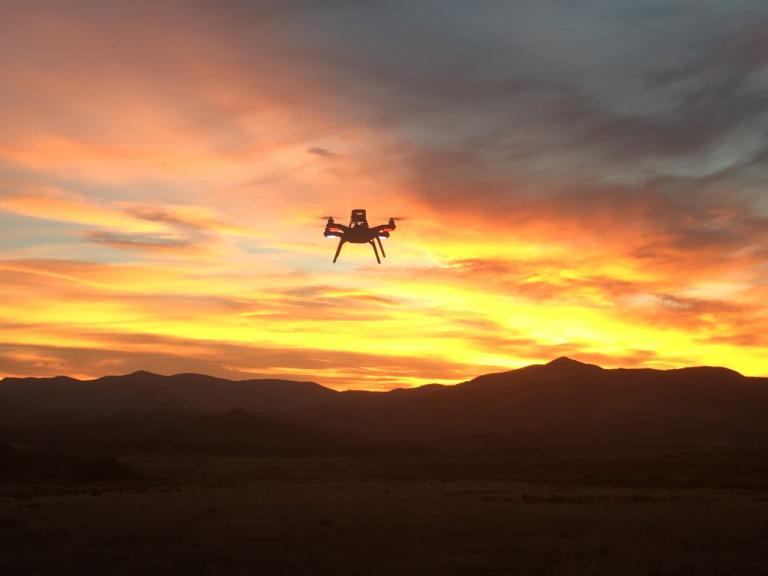
The UAS-DC is expected to be held over the March to August 2024 and aims to demonstrate the capability of UAS to provide data of sufficient quality and reliability on a routine operational basis in support of meeting requirements for upper-air observations, as a component system of the WIGOS Global Basic Observing Network (GBON). Recent progress made includes:
- The finalisation of a new data representation for UAS in CF-NetCDF.
- Monthly meetings of Scoping Planning & Organising Committee (SPOC) have continued so as to refine the scope and plan for the UAS-DC.
- A Subgroup on Airspace Regulation has been formed and met several times having the aim to facilitate improved access to national airspace both during and following the campaign.
- A subgroup of data users has also been formed which will have responsibility for coordinating the role of data users in assessing the quality and impact of the data generated during the event.
- A participant certification form has been developed, approved and made available to participants to provide support for funding applications.
- An update letter to WMO Members was sent including a request to undertake new survey on participation in the UAS-DC - Member agencies are still able to take the survey to identify their likely role in participating in the UAS-DC.
- A third Participants Meeting was held on 14 September.
- Dr Debbie O'Sullivan made a presentation to the WMO Technical Conference on Meteorological and Environmental Instruments and Methods of Observation (TECO-2022)
- The UAS-DC site has continued to be maintained, with recent additions being a page on expected participants and more details on the scope of the campaign & requirements for participation.
The uas-demo wmo [dot] int (WMO Secretariat can be contacted) for more information about the UAS-DC.
wmo [dot] int (WMO Secretariat can be contacted) for more information about the UAS-DC.
JET-ABO Second Meeting & Workshop on Aircraft Derived Data
Second Meeting of the JET-ABO
The second meeting of the INFCOM Joint Expert Team on Aircraft Based Observing Systems (JET-ABO) was held in June as a hybrid meeting, over 27-30 June, with the JET-ABO leadership group and several others attending in person at the WMO headquarters in Geneva, Switzerland.
In addition to reporting on the progress made on the work program of the team by its various subgroups, the meeting also had a focus on the expected future activities and priorities under the ABO programme during the next WMO inter-sessional period (2024 - 2027).
The Chair of the team, Dr Curtis Marshall provided a report to the meeting, in particular addressing:
- The need to strengthen efforts relating to WICAP development, noting that, while the WMO/IATA agreement and regional framework was in place in practice, very little had been achieved in relation to the establishment of new programmes. The team was urged to particularly target projects for development in data sparse areas, highlighting Africa and the Kenya AMDAR Programme and South America, where the LATAM programme had been greatly reduced in coverage recently.
- Efforts currently underway to review and revise the important ABO technical guides, including the Guide to Aircraft-Based Observations (WMO No. 1200) and Chapter 3 of Volume III of the Guide to Instruments and Methods of Observations (WMO No. 8), which need to be readied for submission at the INFCOM second session in October 2022.
- The importance of other sources of ABO in addition to AMDAR, including Automatic Dependent Surveillance – Contract (ADS-C), FLYHT AFIRS and TAMDAR and Mode-S and other related ADS – Broadcast (ADS-B) systems, for which there was a need to develop and improve data management and financial frameworks to ensure their enhancement and extension, their future availability and data quality.
- The excellent work that had been completed so far in relation to the development of the UAS Demonstration Campaign (UAS-DC).
- Data management issues and activities including quality issues such as the known AMDAR air temperature bias, the development of the Lead Centre role and functionality, and the development of the ABO Metadata Repository (ABO-MR).
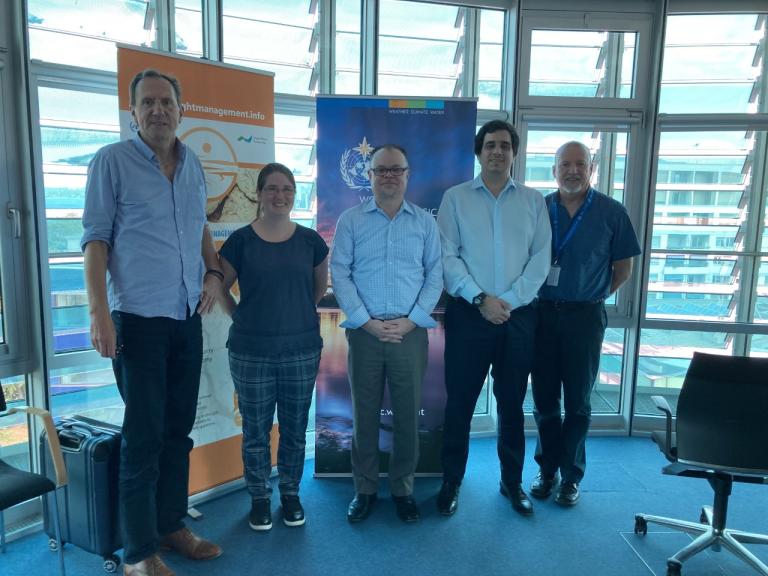
An outcome of the meeting was to agree that there would be a continuing need to have a strong ABO programme within WMO in the future, in particular focusing on likely future key activities and priorties such as:
- Continued efforts to develop the WMO-IATA Collaborative AMDAR Programme (WICAP), including the expansion of water vapour measurement and turbulence monitoring.
- Further collaboration and activities towards the operational integation of UAS observing platforms, intially focused through the holding of the UAS Demonstration Campaign (2024).
- Preparations and planning for the advent of ABO data derived from ADS-B.
- Extension of Mode S and Aircraft Derived Data globally.
- Continued maintenance and improvement of technical materials.
The report of the meeting is available from the WMO Library.
WMO Workshop on Aircraft Derived Data
The WMO Workshop on Aircraft Derived Data (ADD) was held as a hybrid event from the WMO headquarters in Geneva Switzerland over 5-7 September 2022.
The primary aim of the workshop was to raise awareness and share best practices on the potential opportunities and use of aircraft derived data in the meteorological domain, focusing in particular on:
- Technical aspects of Mode S, and ADS-B, ADS-C Aircraft Derived Data.
- Identification of the current status and likely future development scenarios for ADD.
- Discussion on possible ways to collaborate internationally and across the various sectors.
- Identifying risks and requirements for assuring access to data.
- ADD impacts and work done in various NMHS agencies to operationalize Mode-S and other ADD data.
Some of the key recommendations, among others, included:
- WMO should routinely endeavour to meet with key aviation industry stakeholders and standards groups to exchange ideas and provide requirements relating to ADD development.
- The need for a working group on ADD data representation to be formed to guide required developments in development of required codes for ADD exchange.
- A need to obtain and maintain key information and data on secondary surveillance radar and related systems.
- WMO should better coordinate with the ICAO MET Panel for to ensure priority is given to availability of weather information within the emerging ADS-B version 3.
- A need to improve data quality management of ADD.

The workshop program, including presentations and recordings is available from the WMO Community Platform.
AMDAR Provides NWS with Upper-Air Data during Helium and Hydrogen Shortage
A global shortage of helium and local shortages of hydrogen have resulted in the United States National Weather Service (NWS), since the spring of 2022, reducing or eliminating radiosonde flights at several locations. AMDAR data have provided an excellent and reliable replacement at some of these locations. The NWS forecast offices at Albany, New York, Denver, Colorado, and Tallahassee, Florida (indicated by blue stars on the 0000 UTC September 8, 2022 500 mb plot below) did not launch radiosondes during the evening of Wednesday, September 7, 2022.
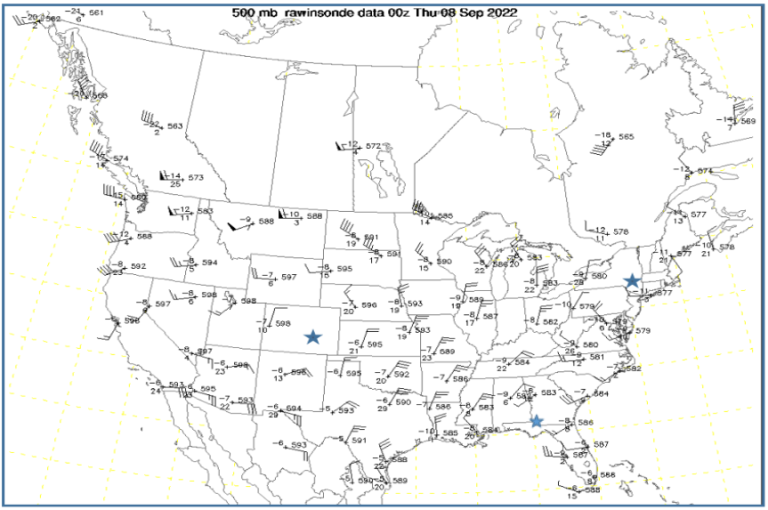
WVSS-II data near the 00z launch time (shown on map below) indicate that AMDAR soundings were available at Albany (ALB) and Denver (DIA), but not at Tallahassee (TLH).
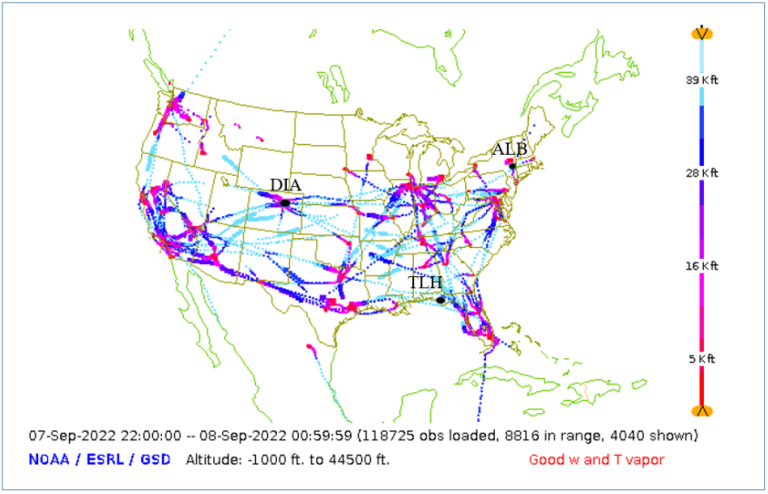
A WVSS- II sounding from Denver (below left) shows a typical High Plains dry, well-mixed environment, while the Albany sounding (below right) is quite moist and cool.

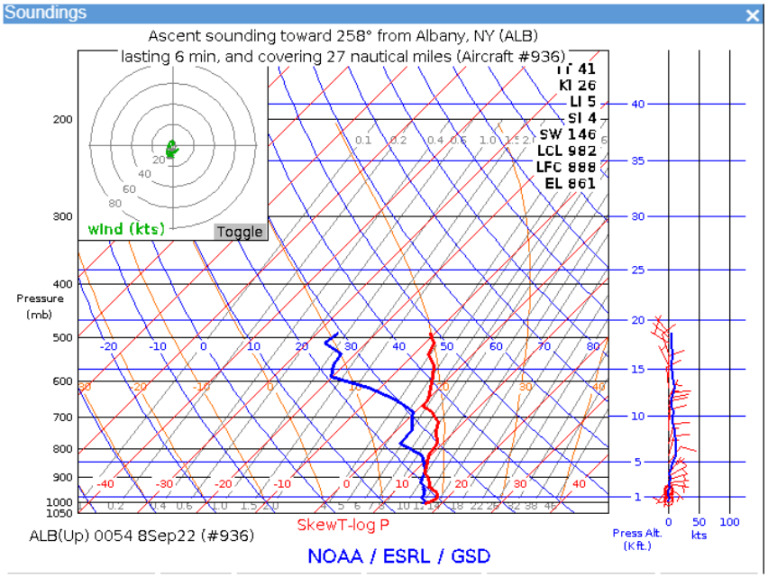
AMDAR Availability at DIA
Radiosondes were curtailed on July 10, 2022 at Denver and had not resumed as of this writing on October 10, 2022. This has resulted in 92 missed radiosonde launches. Fortunately, there were 19,674 AMDAR soundings at DIA during that time period according to statistics compiled at NWS Global Systems Division and available at https://amdar.noaa.gov/new_soundings/?O=D.
The table below shows that 1,496 AMDAR soundings were produced from DIA for the one week period from October 2 - 8, 2022. Soundings were most plentiful between 1300 UTC and 0300 UTC, which corresponds to peak passenger demand, with an average of ten soundings available at 1200 UTC and thirteen soundings at 0000 UTC. All of these profiles have temperature and wind data, and some include moisture observations as well.
Paul Schlatter, Science Officer at the NWS Forecast Office in Boulder, Colorado, said that AMDAR data have been useful during the helium shortage where they have not launched a balloon from KDNR since July. There are numerous flights in/out of DIA with AMDAR soundings available throughout the day. This helps to mitigate the loss of raob data. Even with regular KDNR soundings, AMDAR observations are very useful along the Front Range of Colorado. During downslope wind storms, typically from October through April, the strength of the temperature inversion around the 550 mb level is critical as are the actual winds in the 600mb - 400mb range. AMDAR data help forecasters at the Boulder office track the development and evolution of that inversion. On severe weather days, AMDAR data provide excellent confirmation of the thermodynamic profile of the atmosphere, particularly if the cap is about to break, as well as giving information on the potential for dry microbursts.
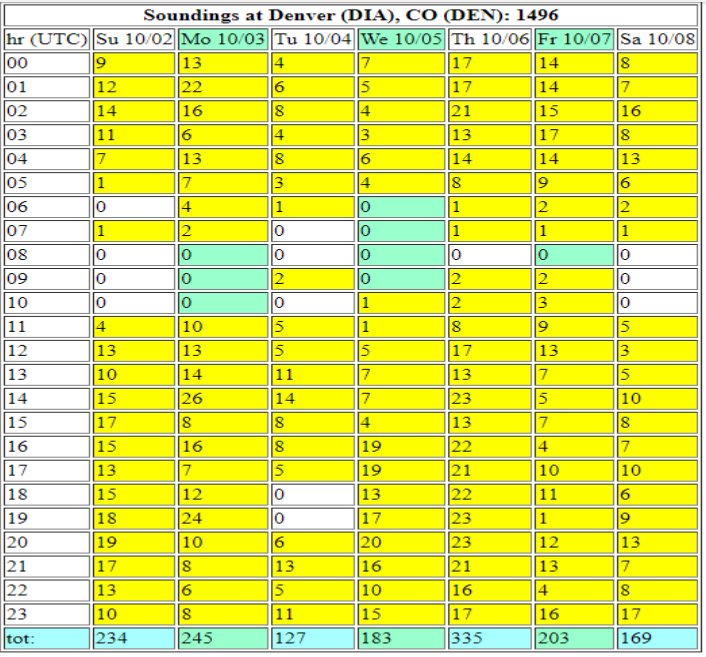
Paul Schlatter, Science Officer at the NWS Forecast Office in Boulder, Colorado, said that AMDAR data have been useful during the helium shortage where they have not launched a balloon from KDNR since July. There are numerous flights in/out of DIA with AMDAR soundings available throughout the day. This helps to mitigate the loss of raob data. Even with regular KDNR soundings, AMDAR observations are very useful along the Front Range of Colorado. During downslope wind storms, typically from October through April, the strength of the temperature inversion around the 550 mb level is critical as are the actual winds in the 600mb - 400mb range. AMDAR data help forecasters at the Boulder office track the development and evolution of that inversion. On severe weather days, AMDAR data provide excellent confirmation of the thermodynamic profile of the atmosphere, particularly if the cap is about to break, as well as giving information on the potential for dry microbursts.
Richard Mamrosh, U.S. National Weather Service, Green Bay, Wisconsin, richard [dot] mamrosh noaa [dot] gov (richard[dot]mamrosh[at]noaa[dot]gov)
noaa [dot] gov (richard[dot]mamrosh[at]noaa[dot]gov)
Contacts
WMO INFCOM, Joint Expert Team on Aircraft-Based Observing Systems Contacts
Chair
curtis [dot] marshall noaa [dot] gov (Mr Curtis Marshall) (USA)
noaa [dot] gov (Mr Curtis Marshall) (USA)
Vice-chairs
carmen [dot] emmel dwd [dot] de (Ms Carment Emmel) (Germany)
dwd [dot] de (Ms Carment Emmel) (Germany)
nrivaben smn [dot] gov [dot] ar (Mr Nicolas Rivaben) (Argentina)
smn [dot] gov [dot] ar (Mr Nicolas Rivaben) (Argentina)
WMO AMDAR Observing System Newsletter Editor
ceweiss1949 gmail [dot] com (Mr Carl Weiss) (USA)
gmail [dot] com (Mr Carl Weiss) (USA)
WMO Aircraft-based Observations
dlockett wmo [dot] int (Mr Dean Lockett) (Switzerland)
wmo [dot] int (Mr Dean Lockett) (Switzerland)
mhuuskonen wmo [dot] int (Ms Minna Huuskonen) (Switzerland)
wmo [dot] int (Ms Minna Huuskonen) (Switzerland)
Subscription & Links
- Newsletter email subscription - complete form & subscribe to: wmo-aircraft-observations-news
- WMO Aircraft-Based Observations
- WMO AMDAR Observing System
- Newsletters
